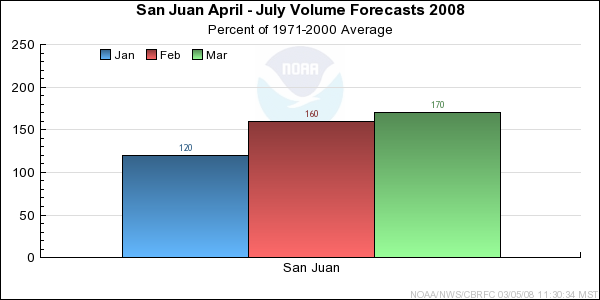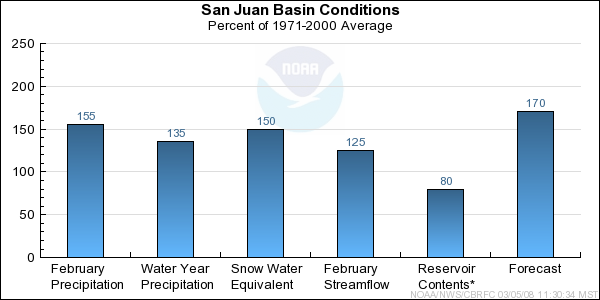San Juan Water Supply Outlook, March 1, 2008
Note: This publication is scheduled for revision. If you have feedback on content, format, or publication frequency, please contact us.
Contents
San Juan Summary
-Model Soil Moisture/Observed Streamflow...Soil moisture for all of the sub-basins in the San Juan
are near normal for the upper portions. However, soil moisture conditions were much above
average for the middle and lower portions of the sub-basins in the San Juan. Observed streamflow
was below average for the headwaters of the San Juan, while the lower portions of the San Juan were
above average.
-Snowpack/Precipitation...Snowpack above Navajo Reservoir remained high at 160 percent of average
while the Animas and the entire San Juan Basin was 150 percent. Precipitation over the San Juan
Basin was 155 percent of average with a seasonal average of 135 percent. The extreme was above
Navajo Reservoir which received 170 percent of average for the month of February and a seasonal
average of 155 percent.
-Short Term Precipitation Forecast...The forecast models through five days keep the San Juan Basin relatively dry
with above average temperatures into the beginning of next week.
-General Discussion...The current snowpack along with both statistical forecast and ESP numbers
suggest raising the forecast across some of the headwaters of the San Juan. The CPC guidance
continues to show the possibility of increased chances of below normal precipitation for
March through May across the San Juan Basin. However, CPC has been forecasting below average
precipitation for the San Juan, and so far the dry forecast has not verified.

*Median of forecasts within each basin.
San Juan Basin Conditions

* Percent usable capacity, not percent average contents.
Click for multi-month Graph.
Differences between the full period forecasts and the residual forecasts may not exactly equal the actual observed volumes due to rounding conventions (see Definitions section).
Precipitation Maps


Hydrologist: Cox





